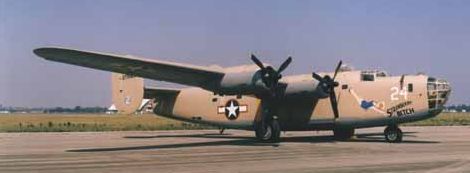Consolidated BQ-8
In 1944 the USAAF intended to convert some worn-out Consolidated B-24D/J Liberator bombers to BQ-8 radio-controlled assault drones for use against heavily defended targets on Japanese islands in the Pacific. The concept was the same as used for the B-17 Flying Fortress conversions in the BQ-7 Aphrodite project. The BQ-8 would take off with two crew, who would then climb to cruise altitude, arm the fuzes, hand the plane over to remote control from an accompanying director aircraft, and bail out. The payload of the BQ-8 consisted of about 11300 kg (25000 lb) of Torpex high-explosive. It is unknown, how many B-24s were actually converted to BQ-8 drones, and the USAAF never flew an operational BQ-8 mission.
 |
| Photo: Air Force Museum Foundation |
| B-24D |
The U.S. Navy had converted at least two PB4Y-1 (their version of the B-24) patrol bombers to assault drones under project "Anvil", but the BQ-8 designation did most probably not apply to these planes. "Anvil" used a complicated remote-control setup. The image of the drone's TV camera was transmitted to a B-17, which then sent course-correction commands to a converted PV-1 Ventura, which actually controlled the drone. Two "Anvil" missions were flown in the North Sea area, but without a definite success. On the first one on 12 August 1944, the PB4Y exploded prematurely and killed both pilots. While the second "Anvil" attack in September that year struck the target area, the accuracy could not be determined because the TV camera had been destroyed by flak. Because of the apparent severe reliability and accuracy drawbacks, project "Anvil" was terminated after the second mission.
Specifications
Note: Data given by several sources show slight variations. Figures given below may therefore be inaccurate!
Data for B-24D (BQ-8 was similar):
| Length | 20.22 m (66 ft 4 in) |
| Wingspan | 33.53 m (110 ft) |
| Height | 5.46 m (17 ft 11 in) |
| Weight | 29000 kg (64000 lb) |
| Speed | 320 km/h (200 mph) |
| Ceiling | 9100 m (30000 ft) |
| Range | 3700 km (2300 miles) (with 2270 kg (5000 lb) bomb load) |
| Propulsion | 4x Pratt & Whitney R-1830-43 piston engine; 890 kW (1200 hp) each |
Main Sources
[1] Bill Gunston: "The Illustrated Encyclopedia of Rockets and Missiles", Salamander Books Ltd, 1979
[2] Kenneth P.Werrell: "The Evolution of the Cruise Missile", Air University Press, 1985
[3] John M. Andrade: "U.S. Military Aircraft Designations and Serials, 1909 to 1979", Midland Counties, 1979
[4] Gordon Swanborough, Peter M. Bowers: "U.S. Military Aircraft since 1908", Putnam, 1989
Back to Directory of U.S. Military Rockets and Missiles, Appendix 1
Last Updated: 21 March 2003